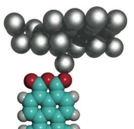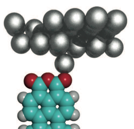Nano knitting
In the realm of transport at the nanoscale, scientists and engineers measure progress by their ability to manufacture devices that are increasingly smaller yet more reliable. Single-molecule devices, in particular, have always shown promise, but despite ongoing advances, it has been difficult to carry out reproducible conductance measurements in geometries that are more complicated than simple point contacts.
In a paper appearing in Physical Review B, Norman Fournier at the Peter Grünberg Institute in Jülich, Germany, and his colleagues test a method to create free-standing molecular wires approximately one nanometer in length and with each end fixed by only a single atom. Three advances appear to be central to reliably reproducing these molecular wires. First, the vibrating tungsten tip that lifts the wire off the metal substrate combines scanning tunneling and atomic force microscopy functionalities. Second, the trajectory through which they raise the wire is optimized through a simulation. Third, the tip monitors the stiffness of the wire as it is pulled up, providing good control over the lifting process. Under these conditions, the particular molecule that the authors study is representative of a broad class of molecular wires and, by extension, is a good tool in the field of precision nanoscience, which includes scenarios such as graphene ribbons. – Sami Mitra





